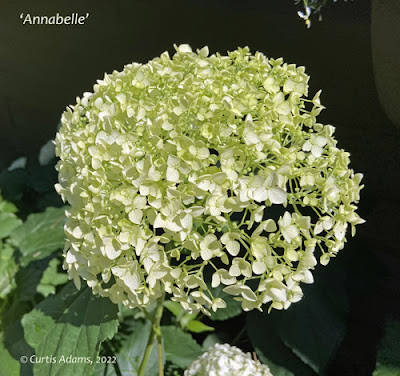Smooth hydrangea, Hydrangea arboescens, is a North American native shrub with a native range is from New York and Massachusetts, south to Florida and west to Oklahoma and Kansas. In the wild it is found in dry to moist woods and hillsides. I thought that the name Hydrangea referred to it growing in, or preferring wet areas. In fact, the name refers to the shape of its seed capsule which resembles that of a water vessel, a hydriai, in Greek.

Here's an example of wild type of smooth hydrangea growing along the
Potomac River near Sharpsburg, MD. This photo was taken in mid-spring.
I was surprised to see that flower buds had already formed.
I really like this plant for
landscaping purposes, particularly in the colder regions. Unlike many of the blue and pink bigleaf hydrangeas
(H. macrophylla), which bloom on
year-old stems, smooth hydrangea blooms on new wood. So whether you prune it or not you will
reliably get blooms. Also there is no
need to protect the plants from winter cold.
This shrub grows really well in shade, in average to moist soils, and will tolerate sun if provided consistent moisture. It is also tolerant of juglone produced by black walnut trees. This makes it an excellent choice for growing under the canopy of walnuts and hickories. Depending on how and when you prune them smooth hydrangea grows as a mounding shrub 3-5’ tall and wide. Flower types are either mophead, large balls of mostly sterile flowers, or lacecap, flattish inflorescences of small fertile flowers surrounded by a rim of larger sterile blooms. One drawback to smooth hydrangea is that, at least in my area, deer really like to eat the leaves. I’ve found that surrounding young plants with chicken wire cages and using deer repellant on larger plants are sufficient to allow the plant to survive deer browsing. Another problem, particularly with the large-flowered cultivars, is flopping. I help support them by running a matrix of strings about 30" off the ground around and between 5 or 6 posts.
 |
| Here's a mass of the 'Annabelle' cultivar a couple of days after a heavy June rainstorm. Once the large blooms dry out, they usually bounce back up. |
My usual maintenance routine starts in early spring when I cut all the stems back to 1 or 2 pairs of viable leaf buds. This will give me a rounded mass about 3-4 feet tall. (Unpruned, they would grow to 5’ or more.) When flower buds begin to form in mid spring I cut about half of the tallest stems by about 1/3. This will give me a second flush of flowers in mid to late summer, as the first set of blooms are fading. I usually leave most or all of the stems in place through the winter since the dried up flower heads still have some interest. Also some bees are able to use the cut stems as nesting sites.
‘Annabelle’ is the most widely known cultivar. I was discovered in the wild in 1910 by Harriet Kirkpartick in the woods near Anna, Il. It has a large white mophead inflorescence of mostly sterile florets. They maintain their appearance for 6-8 weeks. They age to a straw color that is also attractive. These flowers can be dried and used in arrangements for several months (sometimes years). As I have become more aware of how our landscapes affect nature I’ve decided to try to broaden the selection of smooth hydrangea and include some more ecologically useful species and cultivars. In particular I wanted ones that would support pollinators.
Recently the Mt. Cuba Center published an exhaustive trial of smooth hydrangea cultivars and related species. In addition to the horticultural aspects this trial looked at the number and types of pollinators that visited the flowers. Not surprisingly, the lacecap types, both wild type and cultivars, had at least 3 times as many insect visitors as the ‘Annabelle’ cultivar. Two years ago I planted some quart sized lacecap ‘Haas Halo’ cultivars. This year they are producing large blooms.
This year I’ve also added a
wild-type plant. I don’t know exactly
what this will look like when it blooms, but in general these carry much less
visually impressive flowers (to humans) but provide a good source of pollen and
nectar for the insects and a big increase in genetic diversity for any seeds
that may be produced.
So if you are looking for a
medium sized native shrub that blooms in shade take a look at smooth hydrangea,
especially the lacecap types that offer a little more back to your wildlife.








